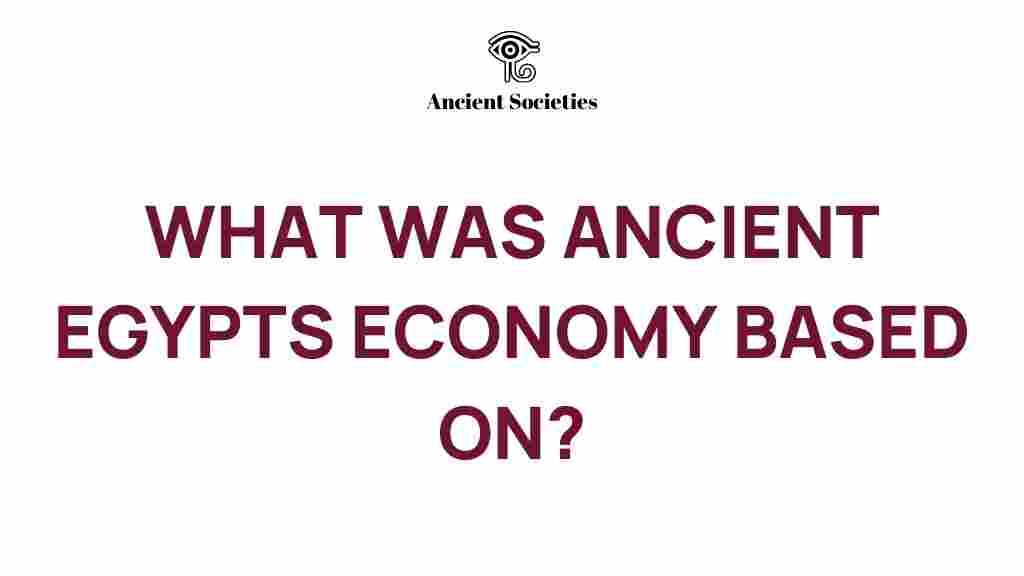Unraveling the Secrets of Ancient Egypt’s Thriving Economy
Ancient Egypt, one of the most remarkable civilizations in history, is often best known for its monumental architecture, captivating mythology, and rich cultural heritage. However, the foundation of this great civilization was its thriving economy, which played a crucial role in its longevity and prosperity. In this article, we will explore the intricate details of Ancient Egypt’s economy, focusing on key elements such as trade, agriculture, currency, labor, resources, wealth, and innovation.
The Role of Agriculture in Ancient Egypt’s Economy
At the heart of Ancient Egypt’s economy was agriculture, which flourished due to the Nile River’s seasonal flooding. This natural phenomenon provided fertile soil, enabling the cultivation of various crops that sustained the population.
- Crops Grown: The primary crops included wheat, barley, flax, and papyrus.
- Irrigation Techniques: Egyptians developed advanced irrigation systems to maximize agricultural output.
- Seasonal Cycles: The agricultural calendar revolved around the Nile’s flooding, known as the inundation, which allowed for three main seasons:
- Inundation (Akhet): The flood season, when land was prepared.
- Emergence (Peret): The planting season, where crops were sown.
- Harvest (Shemu): The time for gathering crops.
As a result of these agricultural practices, Ancient Egypt was able to produce surplus food, which supported a growing population and contributed to the wealth of the civilization.
Trade: The Lifeblood of Ancient Egypt’s Economy
Trade played a vital role in the economy of Ancient Egypt, linking it to neighboring regions and cultures. The Egyptians engaged in both internal and external trade, exchanging goods and resources that were not available locally.
- Internal Trade: Goods were traded between different regions of Egypt. For example, grain from the Nile Delta was exchanged for luxury items from Upper Egypt.
- External Trade: Egypt traded with neighboring civilizations, such as:
- Mesopotamia: For textiles and grains.
- Lebanon: For cedar wood.
- Sudan: For gold and ivory.
Trade routes were established along the Nile and through the desert. The Egyptians used a variety of transportation methods, including boats and caravans, to facilitate trade.
Currency and Wealth Distribution
Unlike many modern economies, Ancient Egypt did not rely heavily on a standardized currency. Instead, the economy functioned on a barter system, where goods were exchanged directly. However, certain items held intrinsic value and acted as a form of currency.
- Barter System: Goods such as grain, livestock, and textiles were commonly exchanged.
- Gold and Silver: Precious metals were used in trade and as a symbol of wealth.
- Taxation: The state collected taxes in the form of goods, which contributed to the centralized economy.
The wealth generated from trade and agriculture allowed the pharaohs to invest in monumental architecture and public works, further enhancing the civilization’s grandeur.
Labor: The Backbone of Ancient Egypt’s Economy
The labor force in Ancient Egypt was diverse and essential for the functioning of the economy. It consisted of skilled artisans, farmers, laborers, and slaves, each contributing to various sectors.
- Skilled Labor: Artisans produced goods such as pottery, jewelry, and textiles.
- Agricultural Labor: Farmers worked the land, with families often involved in cultivation.
- Slave Labor: While some laborers were slaves, many were employed on a seasonal basis during harvest or construction projects.
Labor was organized in a hierarchical structure, with skilled workers often receiving better compensation and status compared to unskilled laborers. This division of labor helped maintain economic stability and productivity.
Resources: The Pillars of Ancient Egypt’s Wealth
Ancient Egypt’s wealth was deeply rooted in its natural resources, which were abundant due to its geographic location.
- Mineral Resources: Gold, copper, and precious stones were mined in the Eastern Desert and Nubia.
- Timber: Cedar wood from Lebanon was highly valued for construction.
- Papyrus: Used for writing and crafting, papyrus was a crucial resource that facilitated trade.
These resources not only contributed to the economic prosperity of Ancient Egypt but also played a significant role in the cultural and artistic achievements of the civilization.
Innovation and Economic Growth
Innovation was a key factor in the development and sustainability of Ancient Egypt’s economy. The Egyptians were adept at adopting new technologies and practices that enhanced their agricultural and trade capabilities.
- Technological Advances: Innovations such as the shaduf (a hand-operated device for lifting water) greatly improved irrigation.
- Construction Techniques: The development of advanced building techniques allowed for the construction of pyramids and temples, which also stimulated the economy.
- Record Keeping: The invention of hieroglyphics and administrative practices helped in managing resources and trade.
These innovations not only boosted the economy but also solidified Egypt’s status as a center of learning and culture in the ancient world.
Troubleshooting Economic Challenges
Despite its many successes, Ancient Egypt faced economic challenges that could impact its stability. Understanding these challenges helps us appreciate the resilience of this civilization.
- Famine: Crop failures due to droughts could lead to food shortages, prompting trade with neighboring regions.
- Invasions: Foreign invasions could disrupt trade routes and resource availability.
- Economic Inequality: Wealth distribution was often uneven, leading to social tensions.
Ancient Egyptians developed strategies to mitigate these issues, such as establishing grain reserves and forging alliances through trade.
Conclusion: The Legacy of Ancient Egypt’s Economy
In conclusion, the economy of Ancient Egypt was a complex and dynamic system that played a fundamental role in the civilization’s development. Through agriculture, trade, labor, and innovation, Ancient Egypt not only sustained itself but also thrived for millennia. The wealth generated from its resources laid the groundwork for monumental achievements in art, architecture, and culture, leaving a lasting legacy that continues to captivate the world today.
To learn more about the fascinating history and innovations of Ancient Egypt, visit this resource. For insights into modern economic systems influenced by ancient practices, check out this article.
This article is in the category History and created by AncientSocieties Team
